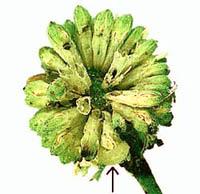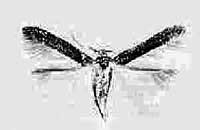
The arrow indicates the rear end of a fully-grown caterpillar
(Photo: courtesy of Rod Elder,
Queensland Beef Industry Institute & Intensive Livestock Section,
a Partner in the Australian Tropical Dairy Institute,
Queensland Department of Primary Industries)
These Caterpillars are yellowish-green with a brown head.
They feed on flowers and buds,
especially of the introduced fodder plant :
Jumbie Bean ( Leucaena leucocephala,
FABACEAE ).

(Picture: courtesy of Rod Elder,
Queensland Beef Industry Institute & Intensive Livestock Section,
a Partner in the Australian Tropical Dairy Institute,
Queensland Department of Primary Industries)
The adult moths have shiny black bodies and forewings.
The forewings are fringed with hairs longer than the actual wingspan.
The hindwings are brown.
The wingspan is about 0.9 cms.
The species occurs naturally in :
India, and
USA,
and was introduced by accident into Australia,
occurring now in
Queensland.
Further reading :
Ian F.B. Common,
Moths of Australia,
Melbourne University Press, 1990, fig. 25.5, p. 256.
Ronald W. Hodges,
The genus Ithome in North America (Walshiidae),
Journal of the Lepidopterists Society,
Volume 15 (1962), p. 89, and also
pp. 83-86 (including figs. 3 & 10)
(updated 21 August 2012, 21 July 2019)







